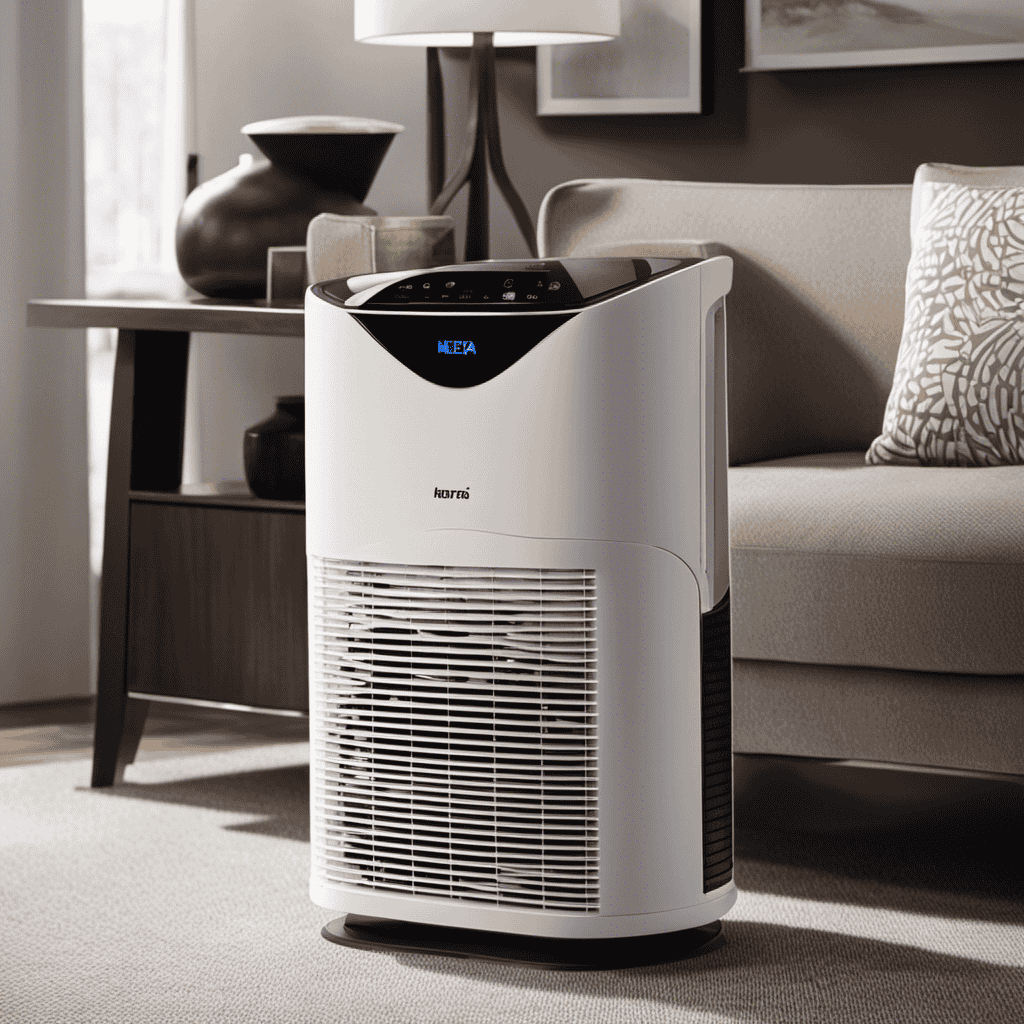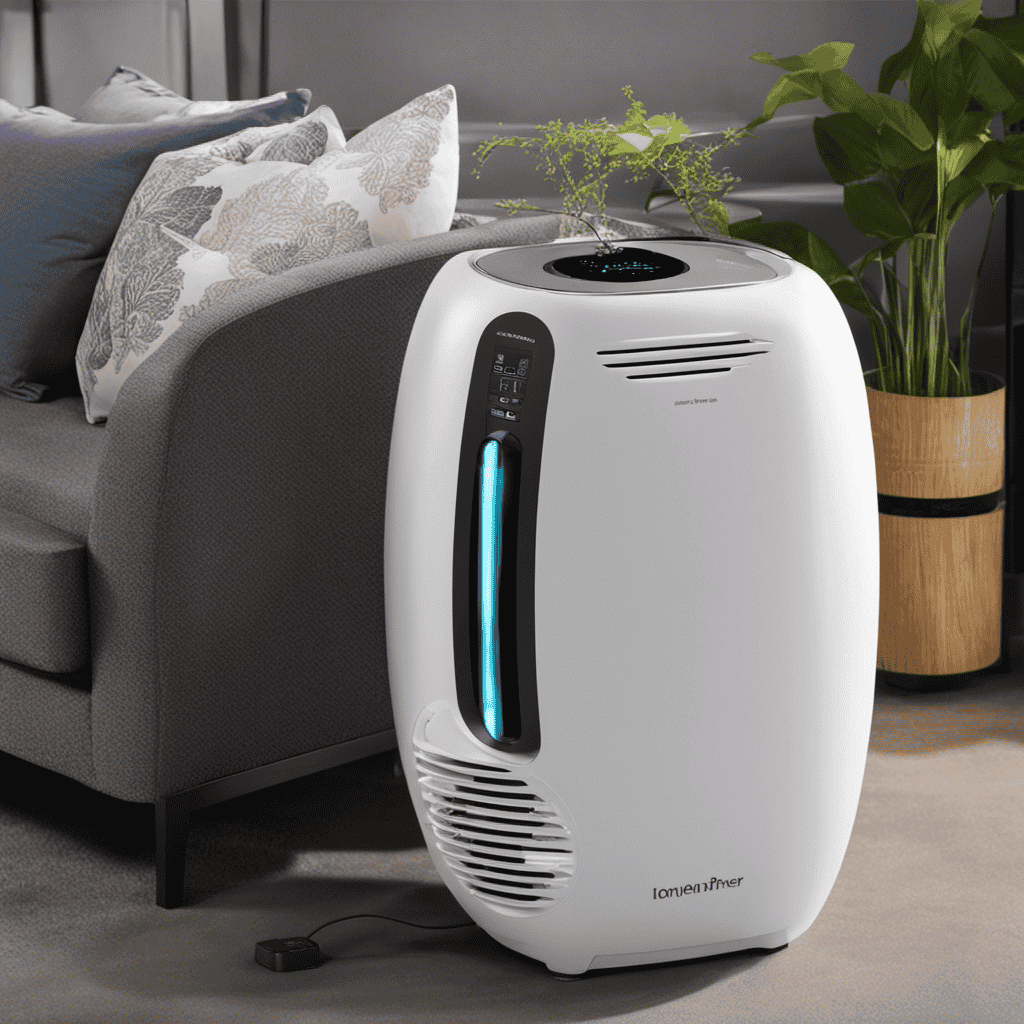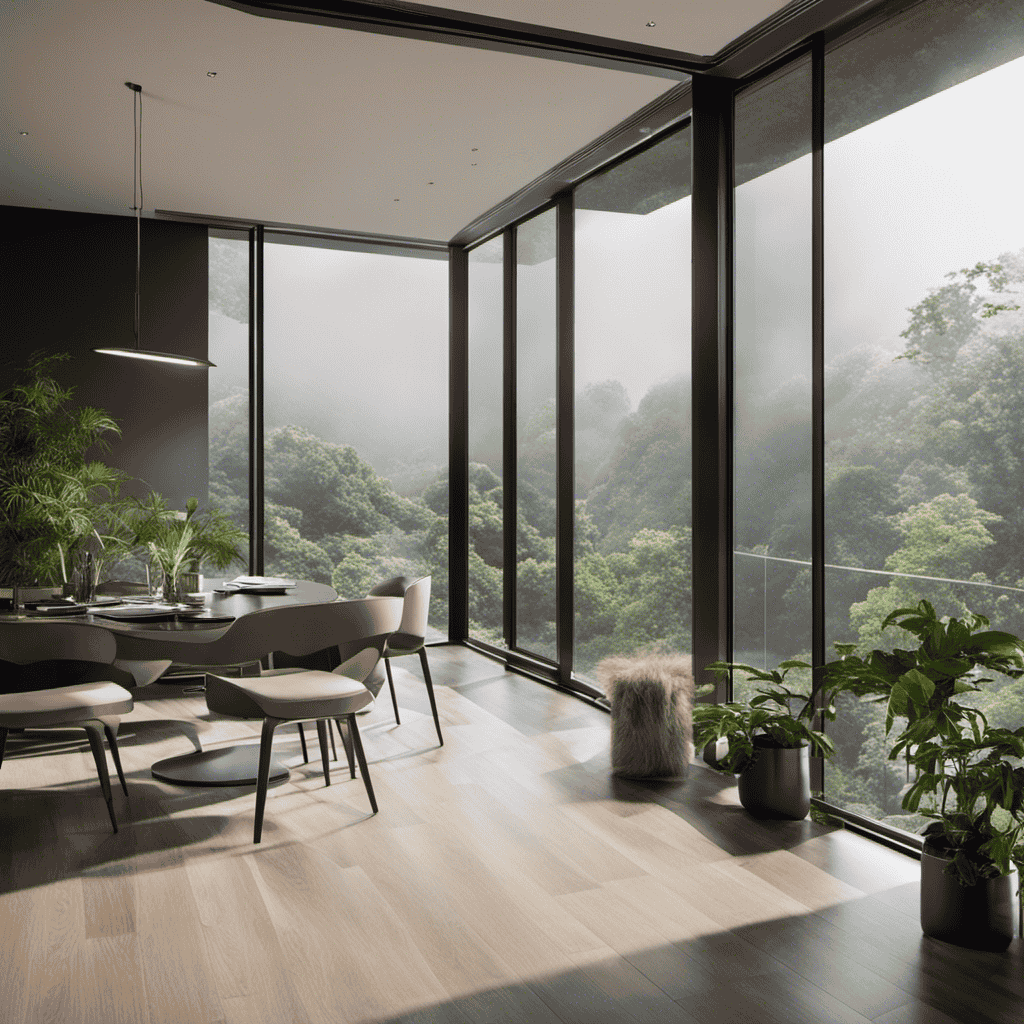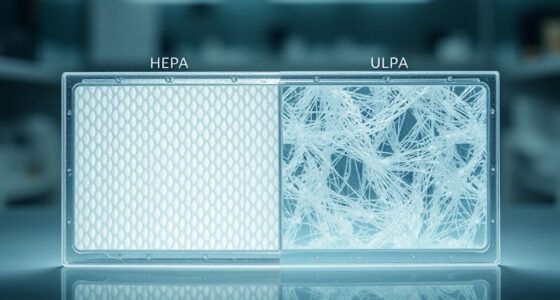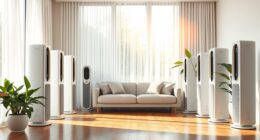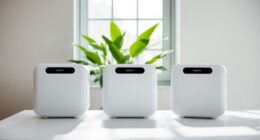Ever pondered the distinction between an air purifier and a HEPA filter?
In this article, I will delve into the key features of air purifiers and the ins and outs of HEPA filters.
We will explore their pros and cons, how they clean the air, and ultimately, compare the two.
By the end, you’ll have a better understanding of the differences and be equipped to choose the right air purifier for your specific needs.
Key Takeaways
- HEPA filters capture particles as small as 0.3 microns and effectively remove common allergens and improve indoor air quality.
- Air purifiers have multiple filters and may include additional features like activated carbon filters for odor removal and UV-C lights for germ-killing capabilities.
- Both air purifiers and HEPA filters require routine maintenance, including filter replacement, for optimal performance.
- Both air purifiers and HEPA filters can provide health benefits by reducing allergens, eliminating unpleasant odors, and removing harmful pollutants from the air.
Key Features of Air Purifiers
If you’re looking for an air purifier, key features you should consider include a HEPA filter and the ability to remove allergens and pollutants from the air.
HEPA stands for High-Efficiency Particulate Air, and a HEPA filter is designed to capture particles as small as 0.3 microns. This makes it highly effective at removing common allergens like dust mites, pollen, pet dander, and mold spores.
However, it’s important to note that regular filter maintenance is necessary to ensure optimal performance. Over time, the filter can become clogged with trapped particles, reducing its effectiveness. Therefore, it’s crucial to regularly check and clean or replace the filter as recommended by the manufacturer.
Advances in air purifier technology have also introduced additional features like activated carbon filters for odor removal and UV-C lights for germ-killing capabilities.
Understanding HEPA Filters
Understanding HEPA filters can help improve the air quality in your home. HEPA stands for High Efficiency Particulate Air, and these filters are known for their ability to capture and trap small particles in the air.
Here are three key benefits of using HEPA filters in your air purifier:
-
Allergen Removal: HEPA filters can effectively remove common allergens such as pollen, pet dander, and dust mites from the air, providing relief for allergy sufferers.
-
Improved Indoor Air Quality: By capturing tiny particles as small as 0.3 microns, HEPA filters can help reduce pollutants in the air, making it cleaner and healthier to breathe.
-
Filter Longevity: Routine maintenance, such as regular filter replacement and cleaning, ensures optimal performance of your HEPA filter and extends its lifespan.
Understanding the benefits and maintenance of HEPA filters is crucial when considering an air purifier.
Now, let’s explore the pros and cons of air purifiers in more detail.
Pros and Cons of Air Purifiers
When considering the pros and cons of air purifiers, two key factors to examine are the filter effectiveness and energy consumption.
Filter effectiveness comparison allows us to assess how well different air purifiers remove pollutants from the air, helping us make informed decisions about which ones are most effective for our needs.
On the other hand, energy consumption analysis helps us understand the energy usage of air purifiers, which is crucial for both cost and environmental considerations.
Filter Effectiveness Comparison
To compare the filter effectiveness of an air purifier and a HEPA, you should consider their ability to remove particles from the air. When it comes to air purification, both options have their benefits and limitations. Here are three key factors to consider:
-
Filtration Efficiency: HEPA filters are known for their high efficiency in capturing particles as small as 0.3 microns, including dust, pollen, pet dander, and mold spores. Air purifiers with HEPA filters can effectively remove these airborne contaminants, improving indoor air quality.
-
Coverage Area: Air purifiers come in different sizes and have varied coverage areas. It is important to choose a purifier that can adequately clean the air in your specific room or space. HEPA filters are commonly found in larger air purifiers, making them suitable for larger rooms.
-
Maintenance and Cost: Air purifiers with HEPA filters require regular filter replacements to maintain optimal performance. It is essential to consider the cost and availability of replacement filters when comparing the long-term maintenance expenses.
Energy Consumption Analysis
The energy consumption of air purifiers and HEPA filters varies depending on the model and size. When it comes to energy efficiency, it is important to consider both the power consumption and the filtration efficiency.
Air purifiers with HEPA filters generally require more energy to operate compared to those with other types of filters. This is because HEPA filters are denser and require more air pressure to push the air through. However, HEPA filters are highly effective in removing particles as small as 0.3 microns, making them ideal for those with allergies or respiratory conditions.
In terms of cost comparison, it is essential to consider not only the initial purchase cost but also the long-term energy consumption. Investing in a more energy-efficient air purifier may lead to cost savings in the long run.
How Air Purifiers Clean the Air
Air purifiers use filters to remove contaminants from the air, improving indoor air quality. These devices are essential for maintaining a healthy living environment.
Here are three key benefits of using air purifiers:
-
Reduces Allergens: Air purifiers effectively capture and remove common allergens such as pollen, dust mites, pet dander, and mold spores. This helps alleviate allergy symptoms and provides relief for individuals with respiratory conditions.
-
Eliminates Odors: Air purifiers can eliminate unpleasant odors caused by cooking, pets, or smoke. They neutralize the odor-causing particles, leaving the air fresh and clean.
-
Enhances Overall Health: By removing harmful pollutants like volatile organic compounds (VOCs), bacteria, and viruses, air purifiers promote a healthier living environment. This can reduce the risk of respiratory infections and other health issues.
To ensure optimal performance, regular air purifier maintenance is necessary. This includes cleaning or replacing filters, checking the unit for any dust buildup, and following the manufacturer’s instructions.
Comparing Air Purifiers and HEPA Filters
When comparing air purifiers and HEPA filters, you’ll want to consider their effectiveness in removing allergens and pollutants from your indoor environment. Air purifiers are devices that work to clean the air by trapping and filtering out airborne particles such as dust, pollen, pet dander, and mold spores. On the other hand, HEPA filters are a type of filter used in some air purifiers that are designed to capture 99.97% of particles as small as 0.3 microns. To help you understand the key differences between air purifiers and HEPA filters, I’ve created a table below:
| Air Purifiers | HEPA Filters |
|---|---|
| Uses multiple filters to remove pollutants | Utilizes a single HEPA filter for filtration |
| Can include additional features like UV light or ionizers | Focuses solely on filtration |
| Requires regular maintenance such as filter replacement | Requires regular maintenance such as filter replacement |
| Can provide health benefits by improving air quality | Can provide health benefits by improving air quality |
In terms of air purifier maintenance, it’s important to follow the manufacturer’s instructions for cleaning and replacing filters. Regular maintenance ensures that your air purifier continues to effectively remove allergens and pollutants, maintaining clean air in your indoor environment. The health benefits of clean air are numerous, including improved respiratory health, reduced allergy symptoms, and better overall well-being. By investing in an air purifier or HEPA filter and properly maintaining it, you can enjoy the benefits of clean air and breathe easier in your home or office.
Choosing the Right Air Purifier for Your Needs
When it comes to choosing the right air purifier for your needs, there are several key points to consider.
First, filter efficiency comparison is crucial in determining how effectively the air purifier can remove airborne particles and pollutants.
Second, room size compatibility should be taken into account to ensure that the air purifier can adequately clean the air in the designated space.
Lastly, noise level consideration is important, as some air purifiers can be quite noisy, which may be a factor to consider for those who are sensitive to noise or plan to use the purifier in a bedroom or quiet space.
Filter Efficiency Comparison
The HEPA filter is more efficient at removing airborne particles than the standard air purifier. This is because HEPA filters are designed to capture particles as small as 0.3 microns, while standard air purifiers may only be able to capture larger particles.
Here are three reasons why the HEPA filter is superior in terms of filter efficiency:
-
Air quality measurements: HEPA filters have been proven to remove up to 99.97% of airborne particles, including dust, pollen, pet dander, mold spores, and even bacteria and viruses. This means that the air you breathe will be cleaner and healthier.
-
Maintenance requirements: While both types of air purifiers require regular maintenance, HEPA filters tend to last longer. Depending on the manufacturer’s recommendations, HEPA filters typically need to be replaced every 6 to 12 months, compared to standard air purifiers which may require filter changes more frequently.
-
Filter effectiveness: HEPA filters are highly effective at trapping even the smallest particles. Their dense filter media is designed to capture particles as small as 0.3 microns, making them ideal for people with allergies or respiratory conditions.
Room Size Compatibility
To determine if an air purifier is compatible with the size of your room, you should consider the Clean Air Delivery Rate (CADR) and the recommended room size provided by the manufacturer.
CADR is a measure of how quickly the air purifier can filter the air in a room. It is important to choose an air purifier with a CADR that matches or exceeds the size of your room.
The recommended room size provided by the manufacturer is also crucial because it takes into account factors such as ceiling height and ventilation. It is essential to follow these guidelines to ensure that the air purifier can effectively clean the air in your room.
Additionally, when comparing prices, it is important to consider the long-term costs of air purifier maintenance, such as filter replacements, to make an informed decision.
Noise Level Consideration
When it comes to choosing an air purifier or a HEPA filter, one important factor to consider is the noise level. As someone who values a peaceful environment, I prefer appliances that operate silently. Luckily, there are soundproofing solutions available for both air purifiers and HEPA filters to minimize noise disturbances in your home.
Here are three soundproofing solutions you can consider:
-
Acoustic Panels: These panels are designed to absorb sound waves and reduce echo, making them an effective solution for reducing noise from air purifiers or HEPA filters.
-
Soundproof Curtains: These curtains are made with special materials that block sound waves from entering or leaving a room. They can be used to create a barrier between the noise source and the rest of your living space.
-
Noise-Canceling Devices: Certain devices, like white noise machines or noise-canceling headphones, can help mask the sound of an air purifier or HEPA filter, allowing you to enjoy a quiet environment.
Frequently Asked Questions
How Much Noise Do Air Purifiers Typically Make?
Air purifiers typically make varying levels of noise depending on the model and fan speed. Noise levels are measured in decibels (dB), with quieter models ranging from 20-50 dB and louder ones reaching up to 70 dB.
Can Air Purifiers Remove Unpleasant Odors From the Air?
Yes, air purifiers can effectively remove unpleasant odors from the air. They are designed to capture and neutralize particles and chemicals that cause odors, improving indoor air quality for pets and overall comfort.
Do Air Purifiers Require Regular Maintenance and Filter Replacement?
Air purifiers require regular maintenance and filter replacement to ensure optimal performance. Regular cleaning of the unit and replacing the filters as recommended by the manufacturer will help maintain clean and fresh air in your space.
Can Air Purifiers Help Reduce Symptoms of Allergies or Asthma?
Air purifiers can help reduce symptoms of allergies or asthma by improving indoor air quality. They remove airborne pollutants, such as dust, pollen, and pet dander, which can trigger respiratory issues. Regular use and maintenance are essential for optimal effectiveness.
Are Air Purifiers Effective in Removing Viruses and Bacteria From the Air?
Air purifiers are effective in reducing airborne pollutants like viruses and bacteria. They are often compared to face masks for virus protection, but air purifiers can provide continuous filtration for larger spaces.
How Does the Pore Size of a Hepa Type Air Purifier Compare to a Regular Air Purifier?
When comparing the pore size of a regular air purifier to a Febreze HEPA type air purifier, the difference is significant. The Febreze HEPA type pore size is much smaller than that of a regular air purifier, allowing it to capture and trap smaller particles, making it more effective in purifying the air in your home.
Conclusion
After thoroughly researching air purifiers and HEPA filters, I can confidently conclude that both are effective in improving indoor air quality.
Air purifiers, with their various features, can remove a wide range of pollutants, while HEPA filters are known for their exceptional ability to capture even the tiniest particles.
While both have their pros and cons, the choice ultimately depends on individual needs. However, one thing is certain: using either of these devices will make your indoor air so clean, it’ll feel like you’re breathing in pure mountain air.
